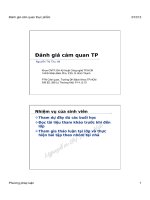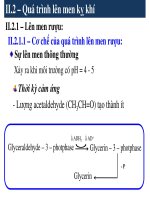Bài giảng phụ gia thực phẩm phụ gia chống oxi hóa (p1) ths đặng bùi khuê
Bạn đang xem bản rút gọn của tài liệu. Xem và tải ngay bản đầy đủ của tài liệu tại đây (1.23 MB, 29 trang )
Phụ gia chống oxi hóa
ThS. Đặng Bùi Khuê
•
Types of Rancidity
•
Types of Rancidity
– Lipolytic rancidity is mainly due to lipases (triacylglycerol acyl hydrolases, EC 3.1.1.3), which
are enzymes catalyzing the cleavage of triacylglycerols (triglycerides) into free fatty acids and
partial glycerol esters—monoacylglycerols (monoglycerides), diacylglycerols (diglycerides),
and glycerol
triacylglycerol
•
Types of Rancidity
– Flavor reversion is a type of rancidity, typical for soybean oil. It is connected with minute
absorption of oxygen by oil
•
Types of Rancidity
– Ketonic rancidity, with a characteristic floral off-flavor, is sometimes observed during the
storage of foods containing short- or medium-chain fatty acids (4–10 carbon atoms), such as
those containing milk fat or coconut oil It is caused by microbial degradation of mediumchain fatty acids into the respective alkan-2-ones or methyl ketones
methyl
ketones
•
Mechanism of
Oxidative Rancidity
•
three main phases
–
–
–
initiation
Propagation
termination
•
Initiation Reactions
– polyenoic (essential) fatty acids
• methylene group adjacent to two double-bonds
•
(-CH=CH–CH2-CH=CH-) is the primary
site of oxygen attack
converted into the respective free radical: R-H ⇒ R* + H*
– Monoenoic fatty acids
• free radicals are formed by cleavage of a hydrogen atom on either one side of the
double bond CH2-CH-CH-CH2⇒C*H-CH=CH-CH2 or CH2-CH=CH-C*H
•
Initiation Reactions
– activation energy of this reaction is higher
– Most often, free radicals are formed by cleavage of a hydroperoxide molecule
•
Propagation Reactions (Primary Reactions)
– forming a peroxy radical
– abstracts a hydrogen atom from another molecule of a polyunsaturated fatty acid, forming a
hydroperoxide and an alkyl free radical
– formation of a free peroxy or alkoxy radical
– polyunsaturated fatty acid is usually isomerized into a more stable conjugated dienoic system
•
Termination Reactions
– recombination of two free radicals
•
Definitions of Antioxidants and Antioxidant Types
•
Mechanism of Action of
Antioxidants
– (1) Antioxidants react with
peroxy radicals produced in
oxidized lipids, forming a
hydroperoxide molecule and
a free radical of the
antioxidant
•
Mechanism of Action of
Antioxidants
– (2) alkoxy free radical formed
during the decomposition of
Hydroperoxides
– (3,4) free antioxidant radicals
react with a peroxy or an alkoxy
radical forming a copolymer
•
Mechanism of Action of
Antioxidants
– (5) free antioxidant radicals
react with another
antioxidant free radical
– (6) free antioxidant radical is
con-verted into an
antioxidant peroxy radical
•
Mechanism of Action of
Antioxidants
– (7) Free antioxidant radical
can also react with some
labile compounds, such as
terpenes, which form free
radicals
Some antioxidants
•
Synthetic Antioxidants Added Directly to Food
– Anoxomer
– Butylated Hydroxyanisole
– Butylated Hydroxytoluene
– Ethoxyquin
– 4-Hydroxymethyl-2,6-di-tert-butylphenol
– 2-(1,1-Dimethylethyl)-1,4-Benzenediol
– 2,4,5-Trihydroxybutyrophenone
•
Anoxomer
–
polymeric antioxidant that is prepared by condensation polymerization of divinylbenzene
(m- and p-) with tert-butylhydroquinone, tert-butyl-phenol, hydroxyanisole,p-cresol, and
4,4′-isopropylidenediphenol
divinylbenzene
tert-butylhydroquinone
p-cresol
4,4′-isopropylidenediphenol
•
Anoxomer
– not less than 98.0% purity
– total monomers, dimers, and trimers below MW 500 not to exceed 1%
– phenol content not less than 3.2 meq/g and not more than 3.8 meq/g
– heavy metals, not more than 10 ppm lead, 3 ppm arsenic or 1 ppm mercury
– in food at a level of not more than 5000 ppm
•
Butylated Hydroxyanisole
– mixture of 2-tert-butyl-4-methoxyphenol and 3-tert-butyl-4-methoxoyphenol
– 3-isomer being 90% or more
– ‘‘hindered’’ phenol, and the tert-butyl group ortho or meta to the hydroxyl group serves to
suppress antioxidant activity
Butylated Hydroxyanisole
3-tert-butyl-4-methoxoyphenol
2-tert-butyl-4-methoxyphenol
•
Butylated Hydroxyanisole
– The steric hindrance is probably responsible for the relative ineffectiveness of BHA in
vegetable oils because the tertiary butyl group interferes with the antioxidant activity of the
phenolic structure
– BHA is commonly used in combination with other primary antioxidants, such as gallates
gallates
•
Butylated Hydroxyanisole
– strong phenolic odor (high temperatures)
– BHA effectively controls the oxidation of animal fats, but is a relatively ineffective antioxidant
in most vegetable oils
•
Butylated Hydroxyanisole
– synergism with acids, BHT, propyl gallate, hydroquinone, methionine, lecithin,
thiodipropionic acid…
– AMIF-72 mixture: contains 20% BHA, 6% propyl gallate, and 4% citric acid in propylene glycol
lecithin
thiodipropionic acid
•
Butylated Hydroxyanisole
– Total BHA must assay at 98.5% minimum, with a minimum melting point of 48°C
– Food
• dehydrated potato shreds 50ppm
• active dry yeast 1000 BHA only
• beverages and desserts prepared from dry mixes (2 BHA only)
• dry breakfast cereals (50)
•
Butylated Hydroxyanisole
• dry diced glazed fruit (32 BHA only)
• dry mixes for beverages and desserts (90 BHA only)
• Emulsion stabilizers for shortenings (200)
• potato flakes (50)
• potato granules (10)
• sweet potato flakes (50)









